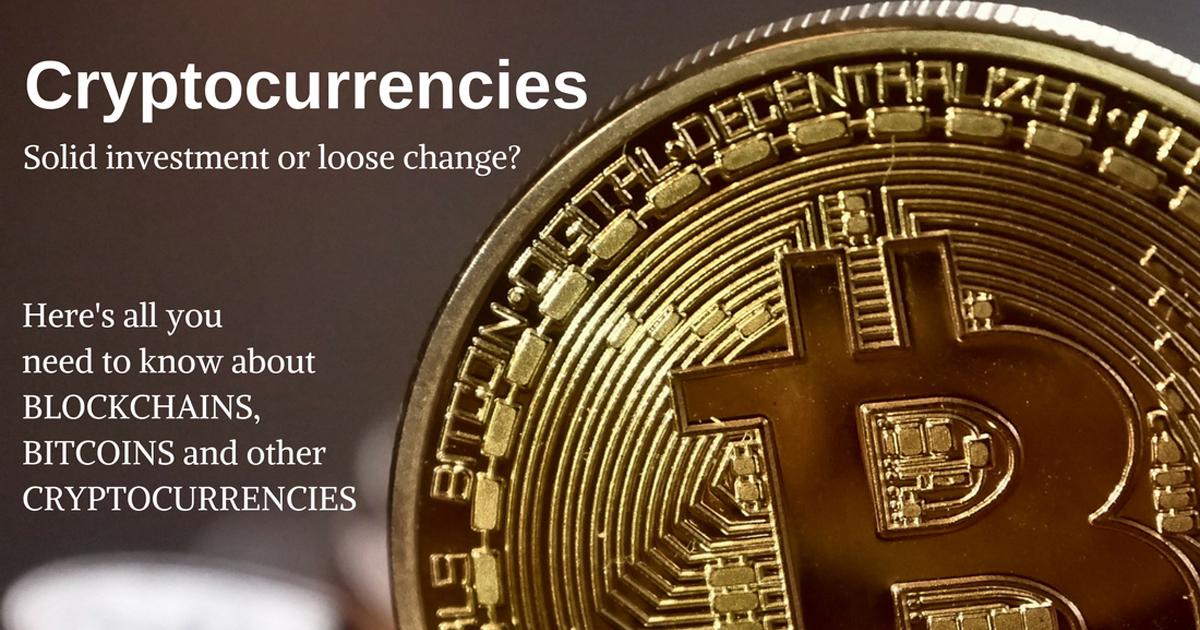Blockchain, Bitcoin & other Cryptocurrencies: What you need to know

Blockchain. Bitcoin. Cryptocurrencies. You’ve probably heard these words popping up more and more often around your office water-cooler, but what do they mean? Let us explain.
Blockchain, Bitcoin and other cryptocurrencies are some of the more exciting technological developments in recent years. But they can be hard to wrap your head around.
Online shopping is one thing. Online shopping with a virtual currency without bank oversight is another.
So are these technologies the future of currency and the next big investment opportunity? Or is this an unsafe, volatile market that’s too risky for investment?
These tricky questions are dealt with below.
So what is a Cryptocurrency?
A cryptocurrency is a virtual, decentralised currency that uses a process called cryptography to provide security.
The first and most famous cryptocurrency, Bitcoin, was created in 2009, but since then there have been many others, like PPCoin and Namecoin.
According to Investopedia, as of September 2015 there were over 14.6 million Bitcoins in circulation with a total market value of $3.4 billion – definitely more than a passing fad.
The defining feature of a cryptocurrency is that it’s digital. That means you’ll never see it offline in hard cash. It exists without a central entity controlling or confirming transactions.
Without a central controller, inventors of cryptocurrency technology had to come up with a system to prevent forgeries and duplicate transactions.
Their solution? A decentralised system of validation which occurs through a network of peers.
In this peer to peer (P2P) system, when a transaction is completed and confirmed, it becomes part of a fixed record of historical transactions – the blockchain.
Without a central entity controlling or confirming transactions, a cryptocurrency is theoretically immune to government interference or manipulation, a factor many investors find appealing.
Although as we’ve recently seen in China, governments can crackdown on cryptocurrencies by shutting down the markets they’re traded on and banning Initial Coin Offerings (ICOs).
So what is Blockchain technology then?
Put simply, a blockchain is a virtual or digital ledger of transactions that supports a cryptocurrency.
When new transactions are made, “blocks” are added to the blockchain. These are managed by a P2P network which follows an established protocol for validating new blocks.
Once a block is confirmed, it cannot be altered or tampered with, therefore making blockchains a vital piece of the cryptocurrency security system.
A key characteristic of blockchain technology is that the information it holds exists on a shared, public and continuously reconciled database and as such, the records it keeps are easily verifiable. It is also remarkably reliable, with the Bitcoin blockchain operating without disruption since its creation in 2008.
Some experts see blockchain technology as having important uses beyond cryptocurrencies, such as crowdfunding and online voting, while others see its potential to lower transaction costs by making payments more efficient.
It’s fair to say signs point to blockchain technology continuing to grow into the future.
So what’s the catch?
Like any new technology, cryptocurrencies and blockchain are not without their risks.
Both technologies have only been around for a few years, and no one knows whether they will be adopted globally or whether they will eventually disappear. The price volatility of Bitcoin reflects this uncertainty.
A real concern for potential investors is government regulation, or more specifically, the potential for governments to ban trading in cryptocurrencies.
China’s recent crackdown had a market-wide impact. The price of one Bitcoin, for example, plummeted from US$4950 to $3226 within two weeks. Less than a month later it had bounced back to US$4772.
Similar price trends were seen for other cryptocurrencies, such as new-kid-on-the-block Ethereum and China’s Antshares.
Another risk is a hack on a cryptocurrency or on the Blockchain itself, which would again affect cryptocurrency price.
According to researchers, about one-third of Bitcoin transactions have been hacked in some way, and two major hacks in 2014 and 2016 significantly pushed down the price of the currency.
Finally, no cryptocurrency has yet overcome starting issues of scalability and timeliness of transactions, which puts a cloud over whether these digital currencies could ever reach their potential to replace traditional cash and gold.
So, should I buy some?
You’ve heard the hype. Your office colleague or footy teammate has probably been shouting from the rooftops that cryptocurrencies and blockchain technologies represent an exciting new frontier for the brave investor.
And sure, the potential for growth, and the prospect that these mechanisms may one day replace our current transactional system, can tempt even the wariest to consider getting involved.
However, while opportunities exist, a wise investment plan always looks for steady growth and long-term gains – not short-term rewards and high risk. Not to mention the need to maintain a balanced portfolio.
For these reasons, smart and prudent investors should take a step back, ignore the hype and do a lot more serious homework before making any decision about dipping their toe in the water, let alone taking the plunge.
And, of course, before you make any hasty decisions, be sure to come in and speak to us first.
Disclaimer: The content of this article is general in nature and is presented for informative purposes. It is not intended to constitute financial advice or a recommendation and may not be relevant to your situation or circumstances. Before taking any action, consider your own particular circumstances and seek professional advice. This content is protected by copyright laws and various other intellectual property laws. It is not to be modified, reproduced or republished without prior written consent.












